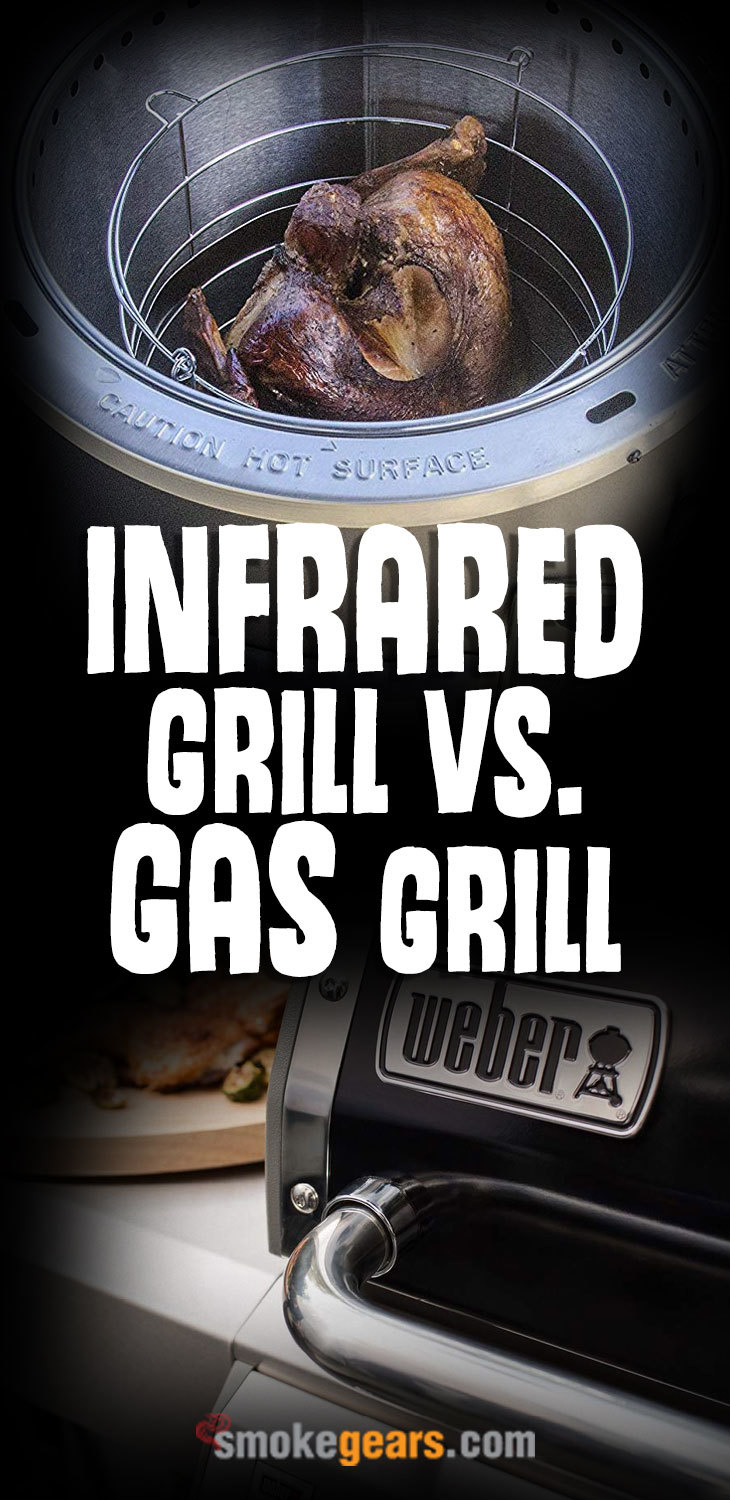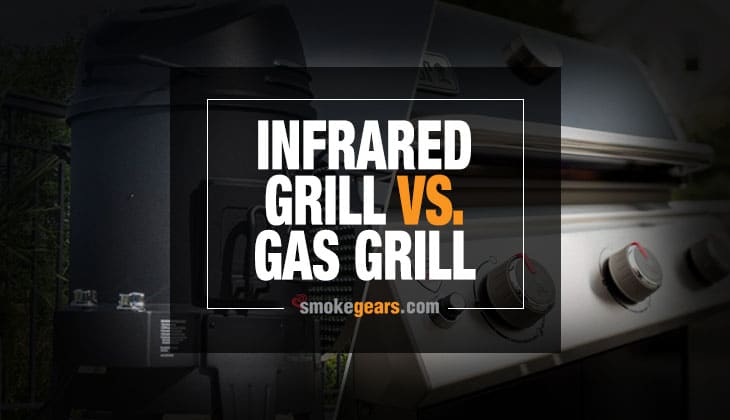Infrared Grill vs Gas Grill | Better Choice of Appliance for Outdoor Cooking Debate
When we plan for any excursion or picnic event, one thing that we always try to include in our plan is barbecue. In such scenarios, the cooking appliance on which we can rely on can either be an infrared grill or a gas grill.
So, what do you want for your next big event?
Before choosing between these two appliances, what we need to know is which one is more comfortable and easier to use.
The primary utility of both items is to roast the food properly. However, the way they work is quite different from each other.
More...
And when we discuss their way of working, we mean their style of operation and utility. In this article, we'll discuss all the details of both grills in detail.
The Different Functions of an Infrared Grill and a Gas Grill
The main thing is that an infrared grill directly heats the food whereas the traditional grill at first heats the air in the appliance and later heats the food with the help of it.
However, this is not all that makes them different from each other. There are a lot of things that can help us differentiate between these two products, even though they are used for the same purpose.
Let's talk about the differences in detail.
1. Safety
When we start to use a product with which we are not that familiar, the first thing that comes to our mind is the uneventful incident that it can cause for us.
As a cooking appliance, in both gas grill and infrared grill, heat or temperature is the primary entity that they produce. However, when we use an infrared grill, the temperature or heat, stays in our control.
We can quickly increase or decrease the temperature. On the other hand, we don't have this option in a gas grill. The heat in this appliance stays uncontrollable and might cause a flair-up, which can become dangerous.
Also, the benefits of using an infrared grill are that it converts the dripping of the food into vapor quickly and makes the food tastier. Whereas when we cook with a gas grill, the moisture of the edible food can cause an eruption, and an unforeseen incident might take place.
2. Cooking Method
While using a grill, we can cook the food using three different methods, which are;
Radiation:
It is the method that is used in an infrared grill. In this, the heat radiates from the machine by using fuel. It spreads the heat in the food evenly, and thus, the risk of undercooked food is highly unlikely with this. This grill produces heat in the form of infrared radiation.
There is a plate or grill in between the gas flame and the food. It gets heated gradually and transfers the heat to the food, which covers the whole surface of the food and cooks it evenly. It works as microwaves while spreading the heat, and the distribution is even and precise.
Direct Heating:
Occurs when the food gets the heat directly from its source. Therefore, this includes uncertain flair-ups while cooking the food, which can be risky.
Despite the risks involved, the results received from it is not satisfying. There is a chance of making the food either undercooked or burned. As a result, an enjoyable occasion can turn into a hectic mess.
Convection:
The conventional cooking method is used in gas or charcoal grills. In this method, the air in the appliance gets heated before the food. And after that, the heated air gets circulated inside the interior of the grill.
This method is not that much reliable cause it makes the food dry and decreases the taste of it. Also, the process is very time consuming and exhausting.
3. Temperature Control
Cooking in an infrared grill is preferable because we have our control over the temperature we cook our food in. The appliance can be pre-heated. So, if we know at which scale our meal needs to be prepared, we can effortlessly set the bar, and watch the machine do most of the work by itself.
Some people are skeptic about overheating the meal and ruining the taste of the edible. However, the smart infrared grill will not burn your food because you can adjust the heat from high to at any temperature in short notice.
In contrast, when we use a traditional gas grill, we need to keep an eye on the heat as it doesn't contain any feature to adjust instantaneously. The uncontrolled temperature becomes a threat to the meal's texture, and without a doubt, the safety of your surroundings.
4. Efficiency
A particular function that makes the infrared grill more sufficient than a gas grill is that it doesn't need to be heated every time we open the lid of the griller to check on the food.
Though it produces high temperatures, it doesn't burn the food as it distributes the heat evenly in the whole grill. But if we look at a gas grill, it doesn't have this quality.
Instead, it needs to be heated whenever we open the lid, and the distribution is uneven. As a result, the meal is dry and inadequately cooked. With an infrared grill, the equation is simple, and that is less effort and more efficiency.
5. Time Consumption
If asked, between a gas grill and an infrared grill that consumes more time, the answer will be the gas grill. In this era, what we often hate to do is unnecessarily waste our precious time. The process of cooking in a gas grill is very lengthy. At first, it takes a couple of minutes to heat the air around the flame.
Then it takes more time to transfer that heat inside the grill. Afterward, slowly, it cooks the food. Also, if we open the lid of the griller, the heat decreases, and eventually, it takes more time to get the warmth again. Due to this long process, the meal inside the grill becomes dry and loses texture.
On the other hand, the infrared grill doesn't take so much time to heat the grill or plate used in it. It has a function to control the temperature because of which, even if we open the lid, it doesn't make any difference. As a result, we get a tasty and juicy meal in a very reasonable time.
6. Stability of Flavor
The taste of the food matters the most than any other thing about it. At the end of the day, a good meal can lift our mood faster than anything else.
An infrared grill keeps the consistency of the eatable. It maintains the moisture of the food and doesn't let the edibles become dry. The cuisine stays juicy and tender.
And on the other hand, when we use a gas grill, it either makes the meal too dry or too moist and stale. It's riskier to cook in a gas grill in comparison to an infrared grill. This is because a gas grill can't bring out all the flavor of the food properly.
7. Manufacture
The construction of an infrared grill is a lot more efficient compared to its counterparts. And the added features make it better and preferable than any other type of roaster. It contains a durable steel burner, a glass panel, and also a cooking grid.
Also, it contains a bigger cooking surface. Another admirable feature is the stainless-steel grid. We can cook better due to this feature, and it also looks more aesthetic. The manufacturing of the gas grill was also done with a considerate method when they were invented.
However, over time, the technology and mechanism used became old and less preferable.
Nowadays, what we need the most on any device we purchase is control. And that is what the gas grill cannot offer. This inability makes the appliance less desirable than an infrared grill.
8. Durability
As the infrared grill has the stainless-steel mechanism, it can endure the humidity better than other outdoor cooking appliances. Another perk of the robust material is that we don't need to think of rust, decreasing its efficiency. The materials enable the machine to endure the change in climate and also the humid temperature.
Unfortunately, this feature is scarce in a gas grill. However, in some gas grills, stainless-steel is being used nowadays.
But still, the overall design and primary heat distribution function used in this grill decrease the durability. It can be burnt when the fuel flares up inside the grill, and the whole grill is susceptible to damage, along with severe harm to the environment.
9. Portability
The infrared grill can be easily carried from one place to another. It can also be organized swiftly without any hassle. On the other hand, moving a gas grill and organizing can be a very tough job.
10. Usage of fuel
An infrared grill uses gas, charcoal, electricity, or wood, less in contrast to a gas grill. It's efficient to utilize the power source correctly. While cooking food, this appliance uses high temperatures and quickly cooks them.
However, while working with a gas grill, we can notice that it only uses a few categories of fuel. Even when we utilize several resources, it simmers the food. Due to its slow process, it consumes a considerable amount of fuel and wastes them. Even after all the consumption, the edibles may not be as delicious as one expects.
11. Expenses
The gas roaster consumes more fuel in comparison to an infrared grill. And that extra use of fuel increases the expenditures of cooking.
As we know, an infrared grill cooks at a high temperature. And because of that, the food becomes edible faster compared to a gas grill. The slower the food cooks, the more energy gets wasted. As an outcome, a considerable amount of resources, including money, is squandered.

But when we use an infrared grill instead of a gas grill, the expenses become less, and we don't need to worry about being profligate.
12. Cleaning
Hygiene is essential for our health. After we cook food, it's necessary for us to clean the mess we make. That's where an infrared grill makes our work easier.
After we finish cooking, we can turn its temperature to the highest point, and that will vaporize all the leftovers in a couple of minutes. But unfortunately, that can't be done with a gas grill as it might flare up and cause an accident.
More Comparisons:
Propane VS Electric Smokers – Which One Is Better?
The Better Choice Between Dyna Glo and NexGrill
Difference Between T Bone and Porterhouse Steak – Talking about Steaks
Broil King Vs Weber Grills: Who Comes out on Top?
Napoleon Grill VS Weber: A Better Choice for a Tasty Grill
Masterbuilt vs Bradley Electric Smokers: Choosing the Optimum One
But What are the Main Pros and Cons of Both Grills?
Every appliance contains both positive and negative qualities. But the balance in them makes them more or less preferable.
Infrared Grill:
Pros:
Cons:
Traditional Gas Grill
Pros:
Cons:
Final Thoughts:
Food is pivotal, whether you're cooking for a home party or doing it for personal pleasure. That's why we must invest our money and energy into that particular appliance which can offer us the preferred edibles.
Despite people's general preference towards the old school grill, I must say that the infrared edition offers so much more.
So, before investing in the wrong product, it's sensible to make the right choice for our betterment. This Infrared Grill vs. Gas Grill article provides all the relevant details regarding the two types of grills available for outdoor cooking.
Therefore, we hope you make the best decision before investing a penny on an appliance.
Remember, good food doesn't only satisfy the physique; it gratifies the soul too!


